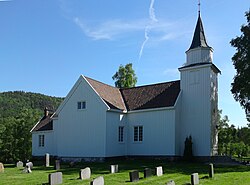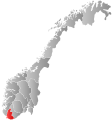Grindheim
Grindheim herred | |
|---|---|
 View of the municipal church | |
 Vest-Agder within Norway | |
 Grindheim within Vest-Agder | |
| Coordinates: 58°26′24″N 07°25′02″E / 58.44000°N 7.41722°ECoordinates: 58°26′24″N 07°25′02″E / 58.44000°N 7.41722°E | |
| Country | Norway |
| County | Vest-Agder |
| District | Sørlandet |
| Established | 1 Jan 1902 |
| Disestablished | 1 Jan 1964 |
| Administrative centre | Byremo |
| Area | |
| • Total | 130 km2 (50 sq mi) |
| *Area at municipal dissolution. | |
| Population (1964) | |
| • Total | 701 |
| • Density | 5.4/km2 (14/sq mi) |
| Demonym(s) | Grinddøl[1] |
| Time zone | UTC+01:00 (CET) |
| • Summer (DST) | UTC+02:00 (CEST) |
| ISO 3166 code | NO-1025 |
| Preceded by | Bjelland og Grindum in 1902 |
| Succeeded by | Audnedal in 1964 |
Grindheim is a former municipality in the old Vest-Agder county, Norway. The administrative centre was the village of Byremo where Grindheim Church is located. The 130-square-kilometre (50 sq mi) municipality existed from 1902 until its dissolution in 1964. It was generally located in the northern part of the present-day municipality of Lyngdal in what is now Agder county.[2]
History[]
The municipality of Grindum was established on 1 January 1902 when the old municipality of Bjelland og Grindum was divided into two separate municipalities: Grindheim (population: 909) and Bjelland (population: 907).
During the 1960s, there were many municipal mergers across Norway due to the work of the Schei Committee. During the 1960s, there were many municipal mergers across Norway due to the work of the Schei Committee. On 1 January 1964, Grindheim (population: 701) was merged with the Ågedal and Midtbø areas (located just east of the lake Ytre Øydnavatnet; population: 96) in Bjelland and the neighboring municipality of Konsmo (population: 712) to create the new municipality of Audnedal.[3]
Name[]
The municipality (originally the parish) was named after the old Grindheim farm (Old Norse: Grindheimr), since the first Grindheim Church was built there. The first element is grind which means "gate" or "wicket" (or possibly grind which means "sand" or "gravel") and the last element is heimr which means "home", "homestead", or "farm".[4][5]
Prior to 1889, the name was written as Grindem. Then from 1889 to 1917, the spelling was changed to Grindum. Then again in 1918, the spelling was changed to its present form: Grindheim.
Government[]
All municipalities in Norway, including Grindheim, are responsible for primary education (through 10th grade), outpatient health services, senior citizen services, unemployment and other social services, zoning, economic development, and municipal roads. The municipality was governed by a municipal council of elected representatives, which in turn elected a mayor.[6]
Municipal council[]
The municipal council (Herredsstyre) of Grindheim was made up of representatives that were elected to four year terms. The party breakdown of the final municipal council was as follows:
| Party Name (in Norwegian) | Number of representatives | |
|---|---|---|
| Labour Party (Arbeiderpartiet) | 3 | |
| Christian Democratic Party (Kristelig Folkeparti) | 2 | |
| Centre Party (Senterpartiet) | 5 | |
| Liberal Party (Venstre) | 3 | |
| Total number of members: | 13 | |
| Party Name (in Norwegian) | Number of representatives | |
|---|---|---|
| Labour Party (Arbeiderpartiet) | 3 | |
| Christian Democratic Party (Kristelig Folkeparti) | 2 | |
| Joint List(s) of Non-Socialist Parties (Borgerlige Felleslister) | 8 | |
| Total number of members: | 13 | |
| Party Name (in Norwegian) | Number of representatives | |
|---|---|---|
| Labour Party (Arbeiderpartiet) | 3 | |
| Christian Democratic Party (Kristelig Folkeparti) | 2 | |
| Joint List(s) of Non-Socialist Parties (Borgerlige Felleslister) | 7 | |
| Total number of members: | 12 | |
| Party Name (in Norwegian) | Number of representatives | |
|---|---|---|
| Labour Party (Arbeiderpartiet) | 3 | |
| Christian Democratic Party (Kristelig Folkeparti) | 3 | |
| Joint List(s) of Non-Socialist Parties (Borgerlige Felleslister) | 6 | |
| Total number of members: | 12 | |
| Party Name (in Norwegian) | Number of representatives | |
|---|---|---|
| Labour Party (Arbeiderpartiet) | 4 | |
| Joint List(s) of Non-Socialist Parties (Borgerlige Felleslister) | 8 | |
| Total number of members: | 12 | |
| Party Name (in Norwegian) | Number of representatives | |
|---|---|---|
| Labour Party (Arbeiderpartiet) | 3 | |
| Local List(s) (Lokale lister) | 9 | |
| Total number of members: | 12 | |
See also[]
References[]
- ^ "Navn på steder og personer: Innbyggjarnamn" (in Norwegian). Språkrådet.
- ^ Store norske leksikon. "Grindheim" (in Norwegian). Retrieved 13 November 2016.
- ^ Jukvam, Dag (1999). "Historisk oversikt over endringer i kommune- og fylkesinndelingen" (PDF) (in Norwegian). Statistisk sentralbyrå.
- ^ Rygh, Oluf (1912). Norske gaardnavne: Lister og Mandals amt (in Norwegian) (9 ed.). Kristiania, Norge: W. C. Fabritius & sønners bogtrikkeri. p. 122.
- ^ "Grindheim" (in Norwegian). Store norske leksikon. Retrieved 26 October 2009.
- ^ Hansen, Tore, ed. (12 May 2016). "kommunestyre". Store norske leksikon (in Norwegian). Kunnskapsforlaget. Retrieved 21 November 2020.
- ^ "Kommunevalgene og Ordførervalgene 1959" (PDF) (in Norwegian). Oslo: Statistisk sentralbyrå. 1960. Retrieved 21 November 2020.
- ^ "Kommunevalgene og Ordførervalgene 1955" (PDF) (in Norwegian). Oslo: Statistisk sentralbyrå. 1957. Retrieved 21 November 2020.
- ^ "Kommunevalgene og Ordførervalgene 1951" (PDF) (in Norwegian). Oslo: Statistisk sentralbyrå. 1952. Retrieved 21 November 2020.
- ^ "Kommunevalgene og Ordførervalgene 1947" (PDF) (in Norwegian). Oslo: Statistisk sentralbyrå. 1948. Retrieved 21 November 2020.
- ^ "Kommunevalgene og Ordførervalgene 1945" (PDF) (in Norwegian). Oslo: Statistisk sentralbyrå. 1947. Retrieved 21 November 2020.
- ^ "Kommunevalgene og Ordførervalgene 1937" (PDF) (in Norwegian). Oslo: Statistisk sentralbyrå. 1938. Retrieved 21 November 2020.
- Lyngdal
- Former municipalities of Norway
- 1902 establishments in Norway
- 1964 disestablishments in Norway


